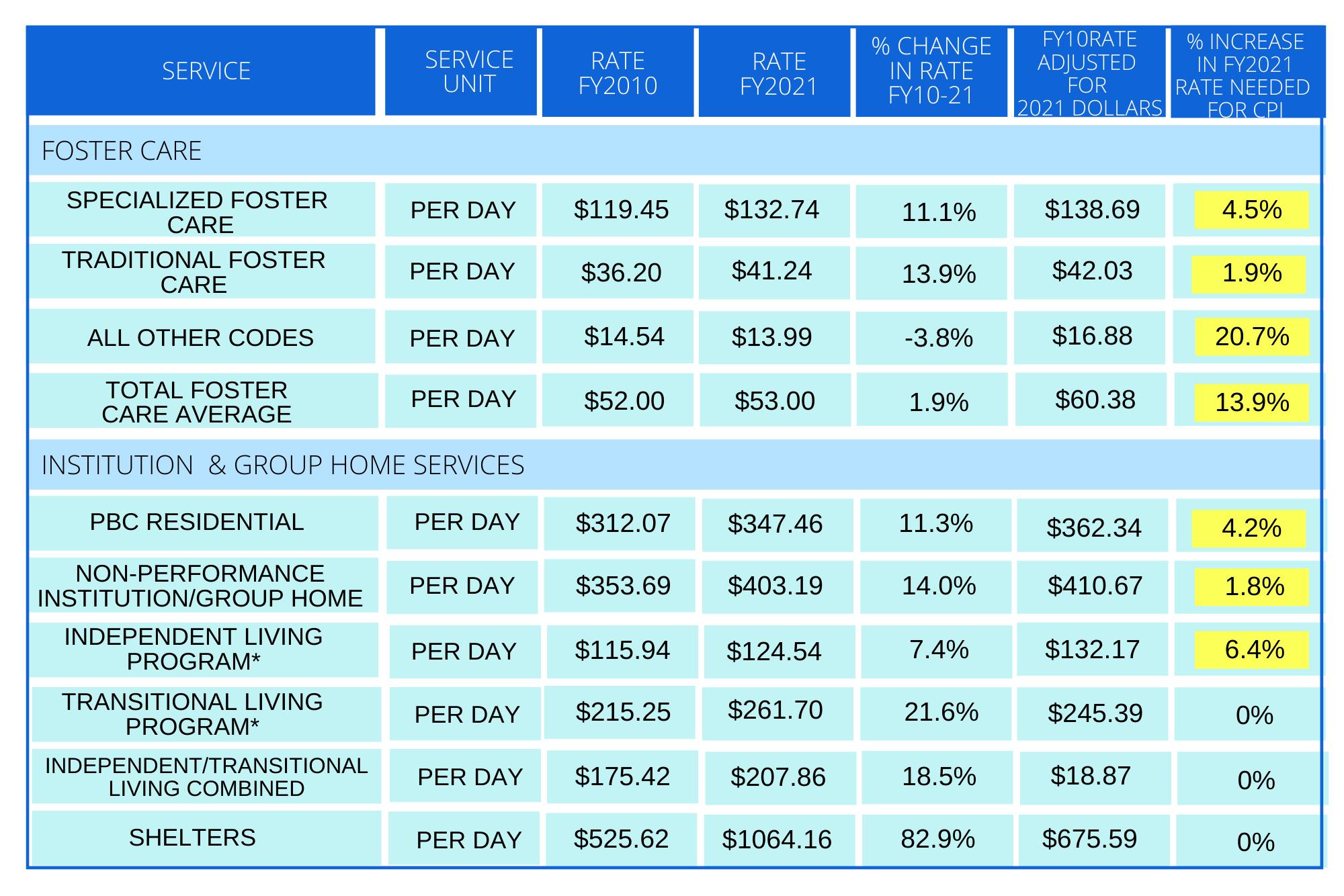
4 minute read
Foster Care and Residential Child Welfare
Foster Care & Residential Child Welfare
Current rates are out of sync with the ever-increasing cost of staff salaries and healthcare benefits, perpetuating high turnover.
Advertisement
Very few rate adjustments have been made over the past 20 years for contracted providers that supply 100% of residential care and 85% of foster care.
Residential and foster care service The Department of Children and Family Services (DCFS) sets rates to reimburse providers for the provision of comprehensive services, providers have staff turnover rates of nearly 40%. including 24/7 therapeutic residential treatment, foster family care 70% of these rates require increases services, licensure, training, monitoring foster homes, facilitating to reach CPI parity. family visits, making critical decisions about child safety and permanency, facilitating referrals, testifying in court, and arranging counseling and therapy. Key reimbursable services are: • Traditional/Home of Relative Foster Care – Supports such as counseling and case management are provided to foster children and both their foster and biological families as they work toward reunification. Providers identify and facilitate other permanency options such as adoption when safe reunification is not possible. • Specialized Foster Care – In addition to Traditional Care services, specialized providers ensure and monitor medical and mental health services for children with an acute health diagnosis through intensive case management, comprehensive mental health services, and other medical, developmental, and educational services specific to each child’s needs. This includes specialized training and support for foster caregivers. • Residential Treatment – Survivors of significant abuse and neglect require intense, trauma-informed, and evidence-based therapeutic interventions in a safe and structured environment. This includes behavior management and psychiatric treatment with the goal of helping each youth heal, cope, and safely return to a family and community setting. • Transitional Living Program – Supervised group living arrangements offering support and monitoring for adolescents age 17-21. • Independent Living Program – Apartment living arrangement for 18-21-year-olds phasing out of the foster care system to help them acquire the life skills necessary for successful independent living. Foster care rates are reimbursed on a per diem basis, with a portion paid to the foster family and another portion paid to the comprehensive case management provider. Currently, there is no regular review or adjustment of rates to ensure they reflect the actual costs of delivering services. In fact, there have been very few adjustments for 20 years to the nonprofit sector providers that supply 100% of residential care and 85% of foster care in Illinois.29
We have historically underfunded our child welfare system, thus extending and perpetuating the racial disparities within it... Children and youth in care, and especially Black children, are paying the price of an underfunded system.
Reimbursement Rate Data
Table 7 demonstrates the average reimbursement rates for foster care and residential care. Fluctuations in average rates over the
years signify changes in the level of need served by each program
rather than increases or decreases in reimbursement rates. The average rates fluctuate annually when foster children transition between high and low-cost programs. While rate calculation follows a standard model, the actual cost is unique to each program. For example, a more intensive residential program requires more staff. Therefore, fluctuations reflect changing patterns and the extent to which various programs are used. The result is that programs end up with their own rates based on the level of need of foster cases being handled by a provider.
PBC=Performance Based Contracting Notes: Table does not include rates paid to foster care families, only those paid to agencies that provide foster care services. Rates increased by a minimum of 2% in FY21. Source: Illinois Department of Children and Family Services, “Big 3” Average Costs FY15./C&G Consulting.

Challenges with Current Rates
One of the biggest challenges experienced by residential and foster care service providers is the ever-increasing cost of staff salaries and healthcare benefits. Currently, many youth care staff entering the residential workforce are paid just over the minimum wage of $11 per hour, contributing to staff turnover rates of nearly 40%.30 There is no mechanism to adjust for cost-of-living increases on an annual basis, yet providers still must account for staff and facility costs, including building maintenance, repairs, and upkeep; transportation and gas; food, and utilities. The investment in youth in need of foster care placement has eroded over time. Residential providers have closed programs, resulting in children remaining in psychiatric hospitals beyond medical necessity, and foster care providers have not been able to maintain salaries that attract and retain the needed workforce. Position vacancies are at an all-time high, further exacerbating the likelihood of children not receiving the critical services needed to keep them safe and move them out of the foster care system in a timely way into permanent family living situations. Black children in Illinois are disproportionately represented in both foster and residential care, and this perpetuates our state’s inability to improve upon a history of disenfranchisement and social injustice.31
29 Illinois Department of Children and Family Services. Illinois Annual Progress and Services Report. (2020). https://www2.illinois.gov/dcfs/aboutus/newsandreports/Documents/APSR_2021.pdf 30 Illinois Partners for Human Service. (2019). The Relationship Between Low Wages, Employee Turnover and Community Well-Being. https://illinoispartners.org/wp-content/uploads/2020/11/The-Relationship-Between-Low-Wages-Employee-Turnover-and-Community-Well-BeingFullReport.pdf 31 Durbin, A. The Rising Number of Children in Foster Care Points out How Illinois Fails Black Women and Their Families (2021). Illinois Collaboration on Youth. https://www.icoyouth.org/2021/03/11/the-rising-number-of-children-in-foster-care-points-out-how-illinois-fails-black-women-and-their-families/





